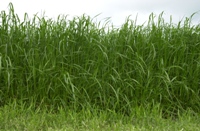Gas from grass – surely not?

Perennial ryegrass
25 April 2008
The humble perennial ryegrass is seen as the unlikely champion of 4 x 4 owners on the school-run as they wave goodbye to Ken Livingstone’s congestion charges, whilst the much-maligned owners of “Chelsea tractors” could soon be laughing all the way to the bank if research currently undertaken at a Welsh research station fulfils its full potential.
The above unlikely scenario, however, could come about sooner rather than later as a result of research into the production of bio-ethanol from grass at Aberystwyth University’s Institute of Biological, Environmental and Rural Sciences*.
"Current experimentation with cellulosic ethanol at IBERS could help to wean us off our dependence on petrochemical fuels in the next ten years", says IBERS's Dr. Steven Fish who added that "A London Transport bus, for instance, could run for a whole year on grass-derived ethanol grown on 11.2 hectares".
The ambitious targets for reduction in C02 emissions suggest that bio-energy crops are currently the only realistic option, and in the greater part of the UK that could mean focusing on grassland areas.
"Much of the previous research work in the field of cellulosic ethanol has focused on fermenting starch from maize, but we think that ryegrass would be a better option for the UK, because it can be grown on land that’s unsuitable for other crops and so does not tie up areas that are needed for food production or animal feed production," he said.
Grassland systems currently account for around two-thirds of the agricultural land area in the UK and, unlike other energy dedicated crops such as willow and Miscanthus, perennial ryegrass is not restricted by winter cold, water availability, soil type or social factors.
Perennial ryegrass enjoys a long growing season, demands low annual nitrogen inputs, especially when grown with clover, and, because it is native to this country, can grow on marginal land at low temperatures. There is the potential for less soil erosion and for the protection of rural economies by allowing diversification away from traditional meat and dairy farming systems.
British farmers are very efficient at growing grass, and are able to take three or more crops off the land annually. More often than not grassland is ensiled to meet the winter feeding requirements of beef and dairy herds but, as dairy and livestock levels are falling, farmers are looking for a new use for grass. Furthermore, a reduction in production to more sustainable winter stocking levels is providing an excess of grass during the summer.
Grassland is important not only for agriculture but also for recreation, leisure and tourism, and it contributes substantially to environmental landscape issues. These functions, however, are not mutually exclusive since an economically viable farming system can benefit tourism and the environment at the same time.
"By 2030, the USA has set itself a target to satisfy 30% of its transport fuel needs via the biomass route. The current need is estimated at 200 billion litres per year, of which 60 billion litres is imported. If all the available maize in the USA were converted to bio-ethanol this would only meet half the target", says Dr Fish.
"Aberystwyth scientists are focusing on high sugar varieties of ryegrass, originally bred at IGER, which has a worldwide reputation for plant breeding. They realise it is one of the most attractive alternative propositions, since there is global availability, yields are high and such feedstocks will not impact on food production."
The urgency for discovery of more renewable sources has further implications for the environment and climate change. One measure taken to address this within a UK context is the Renewable Transport Fuel Obligation (RTFO) which promises a 5% renewable component to transport fuels by 2010.The RTFO recognises the need to use 'oil alternatives' and demonstrates a commitment to the bio-based economy.
The transport fuel additives that will most likely be used to meet the 5% target are bio-ethanol and bio-diesel, both bio-refined from plant-based feedstocks and contributing to a substantial reduction in UK carbon emissions.
* The research was originally undertaken at IGER (The Institute of Grassland and Environmental Research) and is part of a much wider project to find ways of obtaining key chemicals from perennial ryegrass. End products sought by the team could be used in the foods, drinks, textile or surface coating industries. On 17 April IGER merged into Aberystwyth University. As a result the Institute of Grassland and Environmental Research at Plas Gogerddan and two current University Institutes, Biological Science and Rural Sciences, have joined together to form the Institute of Biological, Environmental and Rural Sciences IBERS, creating the UK’s largest group of scientists and support staff in its field.



